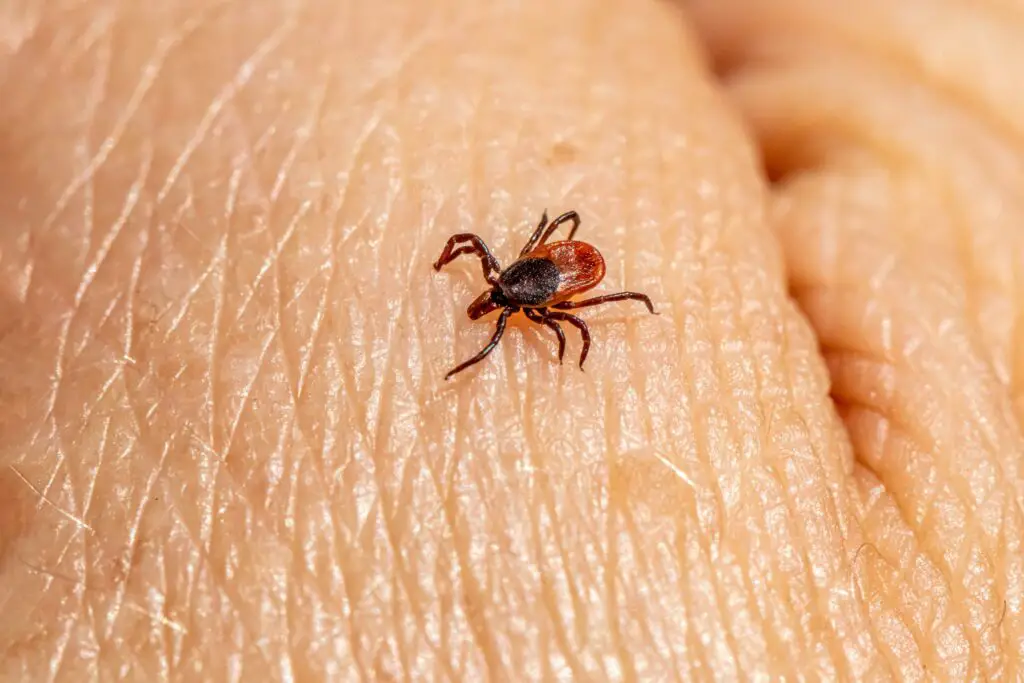Nature is the home to an incredibly versatile array of species, but ticks are definitely one of those that we tend to avoid at all costs.
These tiny arachnids, that are related to spiders, mites, and scorpions, are in fact parasites that survive by attaching themselves to larger animals and feeding on their blood. Humans aren’t spared either. Sadly, these insects carry harmful bacteria that can spread disease to people.
Sadly, tick-borne diseases are at an all-time high, with about 50,000 cases reported each year, and far more going unreported.

There are different types of ticks, and unfortunately, they sometimes find their way to people’s homes. The types most commonly found in homes are the black-legged tick, the dog tick, and the brown dog tick.
- Black-legged Ticks – known as deer ticks, these ticks are typically brown or black in color and have a flattened, oval-shaped body. They are commonly found in wooded areas and can transmit Lyme disease.
- Dog Ticks are larger and can range in color from brown to reddish-brown. They have a tough, shield-shaped body. Dog ticks can transmit diseases such as Rocky Mountain spotted fever.
- Brown Dog Ticks are brown in color and have a slender body.
Although the tick season is between March and October, or sometimes longer, we should be wary of this insects all year round. In fact,if beaten by a tick, a person can develop symptoms even after two or three months.

The bite itself isn’t painful and can cause swelling, itchiness, blistering, and bruising. The bad thing is that ticks also carry and transmit severe diseases, most commonly Lyme disease, as well as Rocky Mountain spotted fever, ehrlichiosis, and babesiosis.
Initially, Lyme disease develops as a circular red ‘bull’s eye’ rash around the site of a tick bite. However, not everyone gets a rash and you should also watch out for a flu-like illness with fever, headache, tiredness and general aches and pains.
The best way to prevent being bitten by a tick is to avoid tall grasses and areas where ticks thrive (such as moorlands and woodlands), especially during the warmer months.
In case you do get bitten, you should remove the tick as soon as possible in order to prevent infections.

These are some of the ways of safe removal.
- Use fine-tipped tweezers: Use clean, fine-tipped tweezers to grasp the tick as close to the skin as possible.
- Pull gently: Apply steady upward pressure, being careful not to squeeze or crush the tick. Aim to remove the tick in one smooth motion without twisting or jerking. Twisting or jerking can cause the tick’s head to break off and stay inside the skin, where it can still transmit disease.
- Clean the area: After removing the tick, clean the affected area with soap and water or an antiseptic solution. Monitor the site of the bite for any signs of infection or a rash, and consult a healthcare professional if necessary.

If by any chance ticks find their way into your home, take immediate action in order to prevent infestation. Most times, ticks are brought into your home in case they stick on your clothes or onto your pets.
- Isolate the area: If you have identified the presence of ticks in a specific area, keep pets and children away from that space.
- Wear protective gear: Put on gloves and a long-sleeved shirt to protect yourself from potential tick bites.
- Clean the area: Clean the area where you found the tick. If it is in bedding, wash the sheets. Inspect the area to ensure there are no more ticks that are present. Dispose of the tick by either flushing it down the toilet or sealing it in a container or ziplock bag before placing it in the trash.
Snoop Dogg’s Heartfelt Tribute: Remembering His Beloved Grandkid Through Their 7 Cherished
Snoop Dogg is famous for his music, but his role as a grandfather shows a different side of him, one filled with joy, loss, and deep love for his family.
Born Calvin Cordozar Broadus Jr., Snoop Dogg has created a career that goes beyond just music; he is also a committed family man. He has been married to Shante Broadus since 1997 and is a father to four children: Corde, 30; Cordell, 27; Cori, 25; and Julian, 26, from a previous relationship.
Over the years, Snoop’s family has expanded, and he is now a proud grandfather, with each grandchild holding a special place in his heart. He is particularly devoted to keeping the memory of one grandchild who passed away alive, ensuring that their legacy continues in the family.

In 2007, Snoop shared his family values while promoting his reality show, “Snoop Dogg’s Father Hood,” which aimed to show the less visible side of hip-hop artists as family men.
Speaking to “People,” Snoop said, “I have kids, and I always play my music for them. I like to know what they like. They think I’m old, but I feel young.”
Looking back on his journey as a father, he said, “Ninety percent of rappers grew up without fathers, but most of them become fathers to their kids. We don’t often get credit for that. We become real men when we reach this point in our lives.”

The coach for Season 26 of “The Voice” has stayed actively involved with his family as it has grown. In a 2015 interview with “Today,” he humbly rated himself as “about a 7-plus” as a father, noting areas where he wants to improve.
“My relationship with my kids is more important than anything. It’s a friendship… it’s based on me being a father, a mentor, and a friend,” he said.
When asked about being a grandfather, Snoop said he planned to be a lenient one, describing himself as a “gullible, get-away-with-everything kind of grandpa.”
Recalling his first experience as a grandparent, he shared, “It’s just a spark of joy to look into his eyes and hold him. I thank my oldest son for making me a grandfather.”

Snoop Dogg’s extended family is a big part of his life. In January 2024, he talked about his grandkids on “The Jennifer Hudson Show,” explaining how each grandchild calls him “Papa Snoop.” This name comes from a nickname his oldest grandson gave him when he was little.
Snoop said, “[My grandkids are] different ages and sizes, but I love them all the same. Actually, my oldest [grandson’s] birthday is today, so I’m on my way to his birthday party.”
He remembered how his oldest grandchild first called him “Papa Noop” because he couldn’t say “Snoop” properly at first.

After his family grew, Snoop faced the tragic loss of one grandchild, which has deeply affected him and his family.
In September 2019, Snoop’s grandson, Kai Love, passed away just 10 days after birth. Snoop shared a heartfelt message on social media, reposting a note that read, “If you’re facing something you don’t understand: Choose to trust God. Remember all He has done for you. His ways are higher than ours. He is always good.”
The post showed Snoop’s faith during his family’s sorrow and received many supportive comments from followers.

One user wrote, “I’m so sorry for your loss. Children are precious gifts from God, but sometimes he takes them back… sweet little Kai RIP… God bless and comfort all who love him….” Another added, “Sorry for your [loss]. God Bless=.” A third user said, “Prayers for you and your family.”
Kai’s parents, Snoop’s son Corde Broadus and his wife, Soraya Love, were heartbroken by the loss. On what would have been Kai’s fourth birthday, Soraya posted a touching tribute on Instagram, sharing her grief and newfound purpose.

“Happy heavenly birthday to my 1st son Kai Love who passed away on 9-15-2019,” she wrote, explaining the pain of losing a child due to a heart defect. Soraya added, “…I know God used this painful time in our lives to help me reach out to others in need of faith and self-awareness.”
Soraya’s post also described how losing her son motivated her to lead a life dedicated to wellness, spirituality, and supporting the community.

Kai’s legacy inspired Corde and Soraya to start the “Kai Heart Foundation,” which aims to spread love and healing through community support.
In a March 2024 post, Soraya shared, “We would love to partner with organizations that help heal, educate, and assist people with LOVE. This is our purpose, and we want to keep giving back to the community.”
In December 2022, Soraya explained, “I started the Kai Heart Foundation in 2019 after my son Kai passed away from a heart defect. He inspired me to help others through acts of LOVE and a healthy lifestyle.”
She expressed gratitude for the guidance she felt from Kai and her faith, inviting support from the community. “Today was magical. Love you all, and if you want to donate for the next event, let me know.”

After experiencing both joy and sadness with the loss of baby Kai, Snoop has continued to embrace his growing family, with each grandchild bringing unique joy and purpose into his life.
Snoop first became a grandfather in January 2015 when his grandson, Zion Kalvin Broadus, was born to Corde and his then-girlfriend Jessica Kyzer.
Proud of this new role, Snoop posted a video saying, “Proud grandad. My son spank n grandson Zion!!Jah bless.” Zion, now 9 years old, is a constant reminder of the family’s growth and Snoop’s commitment to being “Papa Snoop.”
In August 2018, Snoop’s family grew again with the birth of Elleven Love Broadus, Corde’s daughter with Soraya.
Soraya celebrated Elleven’s fifth birthday in 2023 with an emotional Instagram post, writing, “HAPPY 5th BORN DAY TO MY 1st BORN E11EVEN this little Queen taught me how to be a mom when I didn’t know how to change a diaper.”
Elleven brought healing and love into Soraya’s life, adding to Snoop’s family legacy.
In March 2019, Cordoba Journey Broadus was born to Snoop’s son Cordell and his wife Phia. Now 5, Cordoba has shared special moments with Snoop, including attending a Chanel fashion show with him in May 2023.
In February 2021, Snoop welcomed another grandchild, Sky Love Broadus, who is Corde and Soraya’s third child. Shante Broadus, Snoop’s wife, posted about her excitement, saying, “I’m so happy my 5th grandbaby boy was born today .”
In March 2021, Cordell and Phia welcomed their daughter, Chateau Broadus. Shante celebrated her arrival, saying, “I Was Down Earlier But She Just Took All Of That Away My 6th GrandBaby Girl #ChateauBroadus .”
In May 2023, Snoop introduced his youngest grandchild, Symphony Sol, on Instagram, sharing his excitement for the new addition to the family.
Through all the joy and heartache, Snoop Dogg’s love for his family shines brightly. Each grandchild not only represents a new member of the Broadus family but also a legacy of love, strength, and togetherness.
From his own children to his many grandchildren, Snoop’s commitment to family remains strong, grounding him and keeping him connected to his roots as “Papa Snoop.”



Leave a Reply